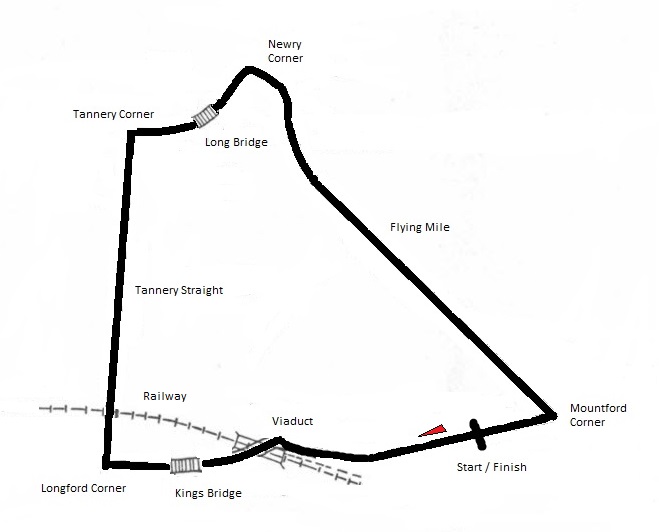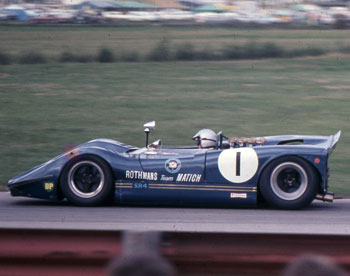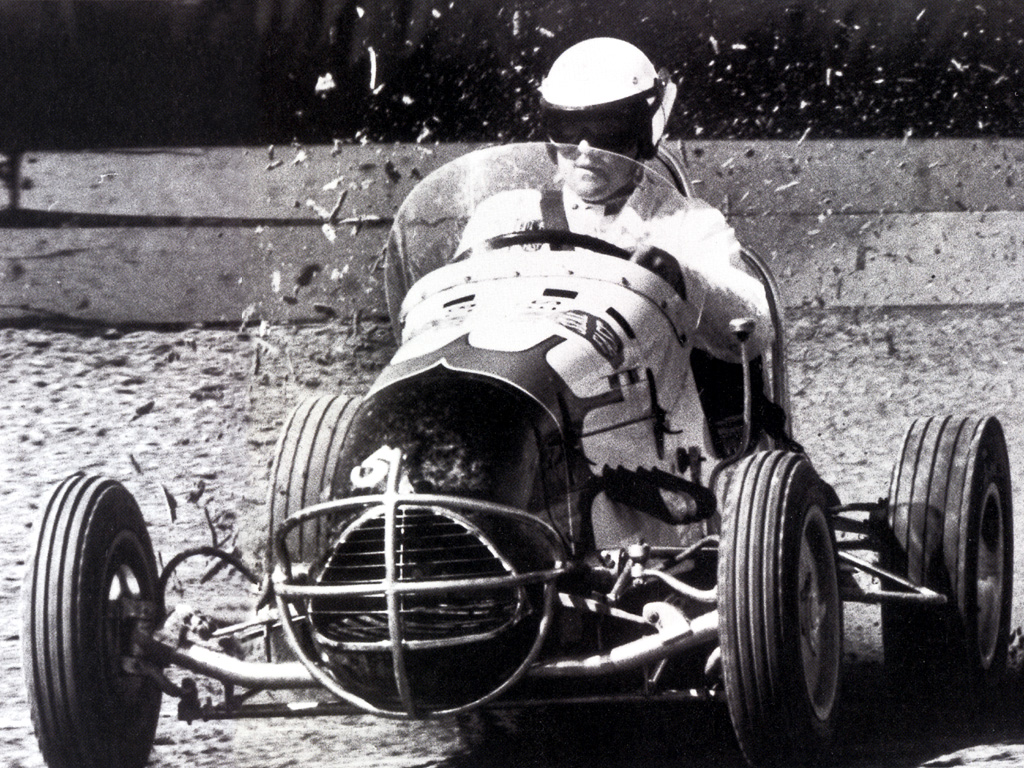|
Longford Circuit
The Longford Circuit was a temporary motor racing course laid out on public roads at Longford, south-west of Launceston in Tasmania, Australia. It was located on the northern edges of the town and its lap passed under a railway line viaduct, crossed the South Esk River via the wooden Kings Bridge, turned hard right at the doorstep of the Longford Hotel, passed over the railway line using a level crossing and traversed the South Esk again via another wooden structure, the Long Bridge. The circuit was in use from 1953 to 1968. History Its first race meeting was held in 1953, the Australian Grand Prix was staged there in 1959 and 1965 and the track hosted a round of the Tasman Series each year from 1964 to 1968. It was also the venue for the single race 1962 Australian Touring Car Championship (at , Longford is the longest circuit ever used in the ATCC), the Australian Tourist Trophy in 1960, 1964 & 1966 and a round of the Australian Drivers' Championship each year from ... [...More Info...] [...Related Items...] OR: [Wikipedia] [Google] [Baidu] |
Longford, Tasmania
Longford is a town in the northern midlands of Tasmania, Australia. It lies 145 m above sea level at the convergence of the Macquarie River and the South Esk River, 21 km south of Launceston and a 15-minute drive from the airport. It is just south of the Illawarra Road, a road connecting the Bass and Midland Highways. It has a population of 3,863 (2016 census) and is part of the Northern Midlands Council area. The region is predominantly agricultural, noted for wool, dairy produce and stock breeding. History Pre-European Settlement The Longford region was the traditional land of The Panninher (par-nin-her) clan of the North Midlands Nation. This clan was known as the Penny Royal Creek Tribe by colonials, named after the old European name for the Liffey River (Aboriginal: Tellerpangger). The Panninher occupied land from Drys Bluff to the Tamar, Evandale and south to the Conara region. The Norfolk Plains region was the site of hunting and the boundary of the Aborig ... [...More Info...] [...Related Items...] OR: [Wikipedia] [Google] [Baidu] |
1960 Australian Tourist Trophy
The 1960 Australian Tourist Trophy was a motor race for sports cars, staged at the Longford Circuit in Tasmania, Australia on Monday, 7 March 1960.Longford Races, Australian Motor Sports, March 1960, pages 108–110 & 118 It was the fourth in a sequence of annual Australian Tourist Trophy races, with each of these being recognized by the Confederation of Australian Motor Sport as the Australian Championship for sports cars.''National Titles'', 1961 CAMS Manual of Motor Sport, page 53 The race was won by Derek Jolly driving a Lotus 15 The Lotus 15 is a front-engine sports racing car designed by Colin Chapman of Lotus Cars, Lotus, built from 1958 until 1960. Series 1 The 15 is a two-seater, front-engine, rear wheel drive sports racer with an aluminium body over a space frame c .... Results Notes * Attendance: 12,000 * Pole position: Ron Phillips * Starters: 22 * Race distance: 24 laps – 108 miles * Race time of winning car: 69 minutes 20 seconds * Fastest lap: Derek Jolly ... [...More Info...] [...Related Items...] OR: [Wikipedia] [Google] [Baidu] |
Frank Matich
Frank Matich (25 January 193511 May 2015) was an Australian racing car driver. A highly successful motor racing competitor in the 1960s and 1970s, Matich built his own range of Matich sports cars and open wheel cars, mainly to support his own career, but some cars found success with other drivers. In these and other makes he won five Tasman Series races, two Australian Grands Prix, the 1972 Australian Drivers' Championship and a number of other Australian motor racing titles. In April 1970, Frank Matich was appointed as a Director of Lambretta (Australasia) Pty Ltd, and was to assemble McLaren racing cars in the Lambretta site in Artarmon, Sydney. Matich, who suffered major electrical burns in a boating accident in 1973, retired from racing in 1974 in order to spend more time with his family and his business. His son Kris Matich became a leading Formula Ford Formula Ford, also known as F1600 and Formula F, is an entry-level class of single seater, open-wheel formu ... [...More Info...] [...Related Items...] OR: [Wikipedia] [Google] [Baidu] |
Leo Geoghegan
Leo Geoghegan (16 May 1936 - 2 March 2015) was an Australian former racing driver. He was the elder of two sons of former New South Wales car dealer Tom Geoghegan, both of whom become dominant names in Australian motor racing in the 1960s. While his younger brother Ian "Pete" Geoghegan had much of his success in touring car racing, winning five Australian Touring Car Championships, Leo spent most of his racing career in open wheel racing cars. Career Leo also drove Group E Series Production Cars and Group C touring cars at the annual Bathurst 500/1000 endurance race for the Ford Works Team, Chrysler Australia and the Holden Dealer Team. This gave him the distinction of being the only driver to race for all three Australian factory backed teams. Leo and Ian Geoghegan drove their Ford Cortina Mk.I GT500 in the 1965 Armstrong 500 at Bathurst while wearing business suits as part of a sponsorship deal with a Sydney clothing store. After crossing the line in second place, the b ... [...More Info...] [...Related Items...] OR: [Wikipedia] [Google] [Baidu] |
Lex Davison
Alexander Nicholas Davison (12 February 1923 – 20 February 1965) was a racing driver who won the Australian Grand Prix four times between 1954 and 1961 and won the Australian Drivers' Championship in 1957. He drove HWM-Jaguar, Ferrari, Aston Martin and Cooper-Climax grand prix cars. Davison won Class A of the 1960 Armstrong 500, forerunner of the Bathurst 1000, driving an NSU Prinz. He competed at the 1961 24 Hours of Le Mans with Bib Stillwell in an Aston Martin DB4GT Zagato. Davison and Stillwell were invited to race for the Essex Racing Stable due to their involvement with Aston Martins in the Australian racing scene. Davison had finished second in the 1960 Australian Grand Prix and fourth in the Australian Gold Star Championship in an Aston Martin DBR4/300. Their Le Mans adventure ended prematurely when a blown head gasket saw them retire on lap 25. Davison won the GT support race at the 1961 British Grand Prix at Aintree driving an Aston Martin DB4 GT Zagato. ... [...More Info...] [...Related Items...] OR: [Wikipedia] [Google] [Baidu] |
Bruce McLaren
Bruce Leslie McLaren (30 August 1937 – 2 June 1970) was a New Zealand racing car designer, driver, engineer, and inventor. His name lives on in the McLaren team which has been one of the most successful in Formula One championship history, winning a total of 8 World Constructors' Championships and 12 World Drivers' Championships. McLaren cars dominated CanAm sports car racing with 56 wins, a considerable number of them with him behind the wheel, between 1967 and 1972 (and five constructors' championships), and have won three Indianapolis 500 races, as well as the 24 Hours of Le Mans and 12 Hours of Sebring. Early life Born in Auckland, New Zealand, Bruce McLaren attended Meadowbank Primary School. As a nine-year-old, he was diagnosed with Perthes disease in his hip that left his left leg shorter than the right. His parents, Les and Ruth McLaren, owned a service station and workshop in Remuera Rd, Remuera, Auckland; Les McLaren had been a motorcycle racing enthusiast, ... [...More Info...] [...Related Items...] OR: [Wikipedia] [Google] [Baidu] |
Jackie Stewart
Sir John Young Stewart (born 11 June 1939), known as Jackie Stewart, is a British former Formula One racing driver from Scotland. Nicknamed the "Flying Scot", he competed in Formula One between 1965 and 1973, winning three World Drivers' Championships and twice finishing as runner-up over those nine seasons. Outside of Formula One, he narrowly missed out on a win at his first attempt at the Indianapolis 500 in 1966, and competed in the Can-Am series in 1970 and 1971. Between 1997 and 1999, in partnership with his son, Paul, he was team principal of the Stewart Grand Prix Formula One racing team. After retiring from racing, Stewart was an ABC network television sports commentator for both auto racing, covering the Indianapolis 500 for over a decade, and for several summer Olympics covering many events. Stewart also served as a television commercial spokesman for both the Ford Motor Company and Heineken beer. Stewart was also instrumental in improving the safety of motor ... [...More Info...] [...Related Items...] OR: [Wikipedia] [Google] [Baidu] |
Denny Hulme
Denis Clive Hulme (18 June 1936 – 4 October 1992), commonly known as Denny Hulme, was a New Zealand racing driver who won the Formula One World Drivers' Championship for the Brabham team. Between his debut at Monaco in 1965 and his final race in the 1974 US Grand Prix, he started 112 Grand Prix, resulting eight victories and 33 trips to the podium. He also finished third in the overall standing in 1968 and 1972. Hulme showed versatility by dominating the Canadian-American Challenge Cup (Can-Am) for Group 7 sports cars. As a member of the McLaren team that won five straight titles between 1967 and 1971, he won the individual Drivers' Championship twice and runner-up on four other occasions. Following his Formula One tenure with Brabham, Hulme raced for McLaren in multiple formats—Formula One, Can-Am, and at the Indianapolis 500. Hulme retired from Formula One at the end of the 1974 season but continued to race Australian Touring Cars. Hulme was nicknamed 'The ... [...More Info...] [...Related Items...] OR: [Wikipedia] [Google] [Baidu] |
Phil Hill
Philip Toll Hill Jr. (April 20, 1927 – August 28, 2008) was an American automobile racing driver. He was one of two American drivers to win the Formula One World Drivers' Championship, and the only one who was born in the United States (the other, Mario Andretti, was born in Italy and later became an American citizen). He also scored three wins at each of the 24 Hours of Le Mans and 12 Hours of Sebring sports car races. Hill was described as a "thoughtful, gentle man" and once said, "I'm in the wrong business. I don't want to beat anybody, I don't want to be the big hero. I'm a peace-loving man, basically."Daley, Robert (1963). ''The Cruel Sport''. Career Born April 20, 1927, in Miami, Florida, Hill was raised in Santa Monica, California, where he lived until his death. He studied business administration at the University of Southern California from 1945 to 1947, where he was a member of the Kappa Sigma fraternity. Hill left early to pursue auto racing, working as a mec ... [...More Info...] [...Related Items...] OR: [Wikipedia] [Google] [Baidu] |
Graham Hill
Norman Graham Hill (15 February 1929 – 29 November 1975) was a British racing driver and team owner, who was the Formula One World Champion twice, winning in and as well as being runner up on three occasions (1963, 1964 and 1965). Despite not passing his driving test until 1953 when he was already 24 years of age, and only entering the world of motorsports a year later, Hill would go on to become one of the greatest drivers of his generation. Hill is most celebrated for being the only driver ever to win the Triple Crown of Motorsport, an achievement which he defined as winning the Indianapolis 500, the 24 Hours of Le Mans, and the Formula One World Drivers' Championship. While several of his peers have also espoused this definition, including fellow F1 World Champion Jacques Villeneuve, the achievement is today most commonly defined as including the Monaco Grand Prix rather than the Formula One World Championship. By this newer definition, Hill is still the only driver to ... [...More Info...] [...Related Items...] OR: [Wikipedia] [Google] [Baidu] |
Jim Clark
James Clark Jr. OBE (4 March 1936 – 7 April 1968) was a British Formula One racing driver from Scotland, who won two World Championships, in 1963 and 1965. A versatile driver, he competed in sports cars, touring cars and in the Indianapolis 500, which he won He was particularly associated with the Lotus marque. Clark was killed in a Formula Two racing accident in 1968 in Hockenheim, At the time of his death, aged 32, he had won more Grand Prix races (25) and achieved more Grand Prix pole positions (33) than any other driver. In 2009, ''The Times'' placed Clark at the top of a list of the greatest-ever Formula One drivers. Early years James Clark Jr was born into a farming family at Kilmany House Farm, Fife, the youngest child of five, and the only boy. In 1942 the family moved to Edington Mains Farm, near Duns, Berwickshire, in the Borders. He was educated at primary schools in Kilmany and then in Chirnside. Following three years of preparatory schooling at Clifton ... [...More Info...] [...Related Items...] OR: [Wikipedia] [Google] [Baidu] |
Jack Brabham
Sir John Arthur Brabham (2 April 1926 – 19 May 2014) was an Australian racing driver who was Formula One World Champion in , , and . He was a founder of the Brabham racing team and race car constructor that bore his name. Brabham was a Royal Australian Air Force flight mechanic and ran a small engineering workshop before he started racing midget cars in 1948. His successes with midgets in Australian and New Zealand road racing events led to his going to Britain to further his racing career. There he became part of the Cooper Car Company's racing team, building as well as racing cars. He contributed to the design of the mid-engined cars that Cooper introduced to Formula One and the Indianapolis 500, and won the Formula One world championship in 1959 and 1960. In 1962 he established his own Brabham marque with fellow Australian Ron Tauranac, which in the 1960s became the largest manufacturer of customer racing cars in the world. In the 1966 Formula One season Brabham be ... [...More Info...] [...Related Items...] OR: [Wikipedia] [Google] [Baidu] |









